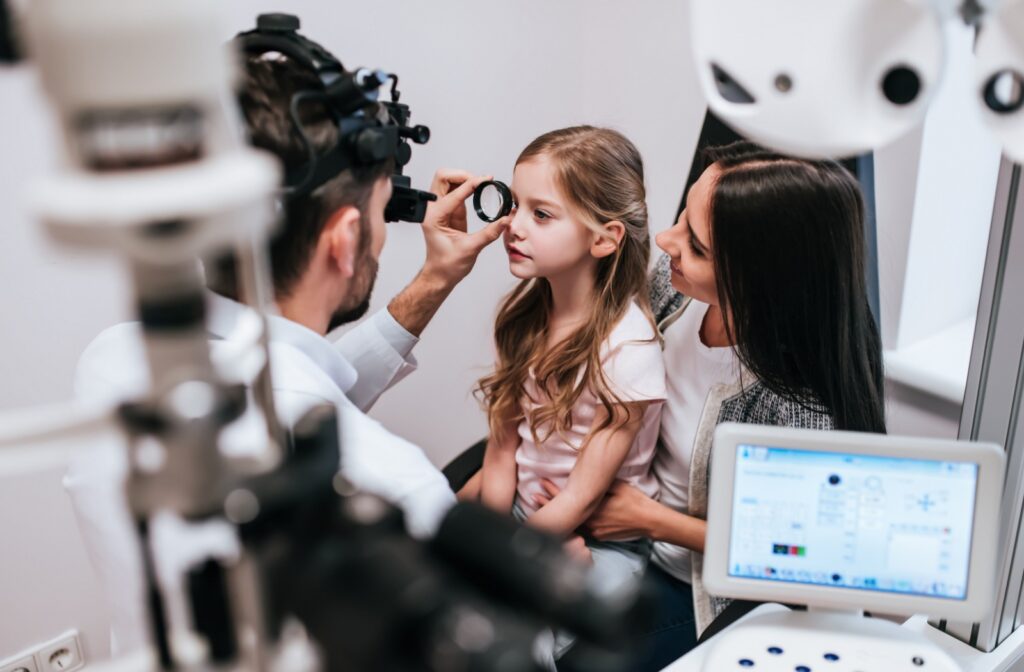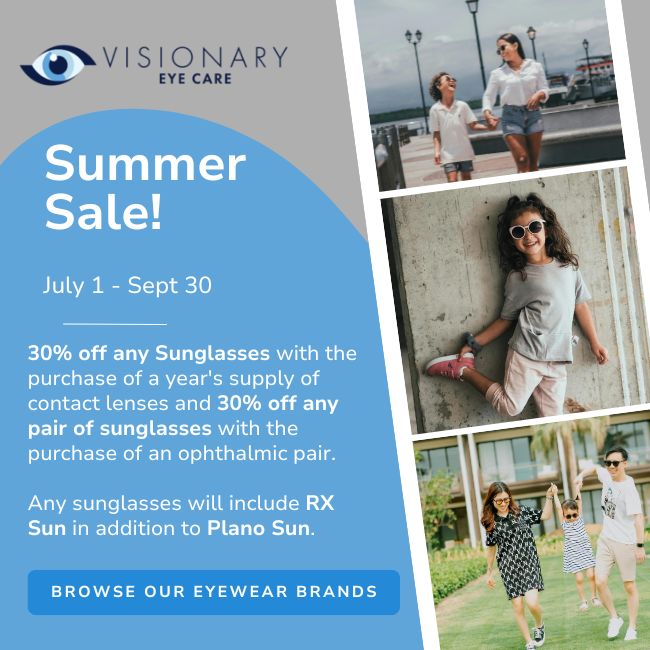Many parents wonder if their child’s nearsightedness will get better as they grow older. The short answer is that myopia typically doesn’t improve with age—in fact, it often worsens during childhood and adolescence.
But there’s good news! Understanding how myopia develops and progresses can help you take proactive steps to slow its advancement and protect your child’s future vision. Once your child is diagnosed during a comprehensive eye exam, there are myopia control options available to help slow the progression of the condition.
Understanding Myopia
Myopia, commonly known as nearsightedness, is a refractive error that makes distant objects appear blurry while close objects remain clear. This condition occurs when the eye grows too long or the cornea becomes too curved, causing light to focus in front of the retina rather than directly on it.
The prevalence of myopia has increased dramatically worldwide. Research shows that, by 2050, nearly half of the global population may be myopic. Myopia typically develops during childhood and tends to worsen until the late teens or early twenties.
Causes of Myopia
Understanding what causes myopia can help parents make informed decisions about their child’s eye health. Several factors contribute to the development and progression of nearsightedness.
Genetic Factors
Genetics plays a significant role in the development of myopia. If one parent is myopic, their child has a higher chance of developing the condition. But genetics alone doesn’t determine whether a child will develop myopia.
Environmental Factors
The environment in which children spend their time has a significant influence on the development of myopia. Limited exposure to natural light and spending excessive time indoors can increase the risk of developing nearsightedness.
Research suggests that children who spend at least 2 hours per day outdoors have lower rates of myopia. Natural sunlight exposure appears to trigger chemical signals in the retina, which may help prevent the abnormal eye growth that leads to myopia.
Lifestyle Influences
Modern lifestyle habits contribute significantly to rising myopia rates. Extended periods of near work, such as reading, writing, or using digital devices, can strain the eyes and potentially accelerate myopia progression.
How Age Affects Myopia Progression
Myopia typically develops between the ages of 6 and 14, with the most rapid progression occurring during the school years. The condition rarely improves on its own and usually continues to worsen until the late teens or early 20s.
During childhood and adolescence, the eyes continue to grow and develop. This growth period coincides with increased academic demands and screen time, creating conditions that can accelerate myopia progression.
Benefits of Myopia Control
Myopia control focuses on slowing the progression of nearsightedness rather than simply correcting vision with glasses or contact lenses. This proactive approach offers several important benefits for children’s long-term eye health.
Slowing myopia’s progression can significantly reduce the risk of developing high myopia later in life. High myopia is associated with serious eye complications, including retinal detachment or glaucoma. Even a modest reduction in myopia progression can make a difference in long-term eye health outcomes.

Myopia Control Methods
At Visionary Eye Care, we offer a range of evidence-based myopia control options to help slow the progression of myopia in children, including MiSight contact lenses, Multifocal contact lenses, and Multifocal or bifocal spectacles. These treatments work by altering how light focuses on the retina, helping to reduce the rate of eye elongation over time.
Additionally, we offer Synch lenses, which are specially designed to relax the eye’s focusing effort during near tasks like reading or screen use. These lenses may help slow the progression of myopia in children.
MiSight 1 Day Contact Lenses
MiSight contact lenses are daily disposable lenses designed specifically for children with myopia. These lenses work by altering how light focuses on the retina, slowing eye elongation while delivering clear vision throughout the day.
Multifocal Contact Lenses
Multifocal soft contact lenses can provide both vision correction and myopia control. These lenses have different power zones that slow the progression of myopia by changing how light reaches the eye.
Multifocal contact lenses are particularly suitable for active children who participate in sports or prefer not to wear glasses.
Multifocal or Bifocal Eyeglasses
Multifocal or bifocal spectacles are also available as a non-invasive method to help control myopia. These glasses provide different lens powers to support both clear vision and reduce strain on the eye’s focusing system, which may help slow myopia progression.
We are currently awaiting FDA approval of myopia control glasses in the United States. Once approved, these may offer another effective tool in managing childhood myopia.
Preventing Myopia
While not all cases of myopia can be prevented, especially given that genetic factors are involved, parents can take several steps to reduce their child’s risk of developing nearsightedness.
Encourage Outdoor Time
Spending time outdoors is one of the most effective ways to reduce the risk of myopia. Simply playing in the backyard, walking to school, or having lunch outside can make a difference.
The key is exposure to natural light and having opportunities to focus on distant objects. Spending at least 2 hours outdoors daily has been shown to slow the progression of myopia in children.
Limit Screen Time
While digital devices are part of modern life, excessive screen time can contribute to myopia development. Parents should establish reasonable limits on recreational screen time and ensure children take regular breaks from digital devices.
Regular Eye Exams
At Visionary Eye Care, we offer specialized infant screenings through the InfantSEE® program, a public health initiative from the American Optometric Association (AOA) that provides no-cost vision assessments for babies 6 to 12 months old. These early evaluations help identify potential issues before they interfere with development.
If no concerns are found during the InfantSEE screening, we recommend beginning comprehensive eye exams at age 2 to 3 years old, unless parents notice specific concerns. After that, yearly exams are advised for children of all ages. Early detection and intervention are crucial for effectively managing myopia.
Regular eye exams allow your child’s eye doctor to monitor changes in vision and implement myopia control strategies when appropriate. Even children without obvious vision problems should have routine eye exams, as myopia can develop gradually.
Take Action for Your Child’s Vision
Myopia doesn’t improve with age, but that doesn’t mean parents are powerless. With proper understanding and proactive management, you can help protect your child’s vision and reduce their risk of developing high myopia and its associated complications. The key is early intervention and consistent care. Call our team at Visionary Eye Care today and book an appointment for a comprehensive eye exam. We specialize in children’s eye care and myopia control, and can assess your child’s risk factors and recommend the most appropriate treatment options.



